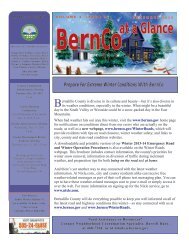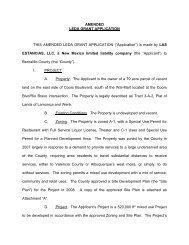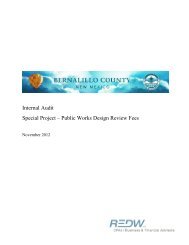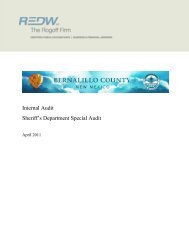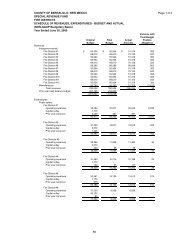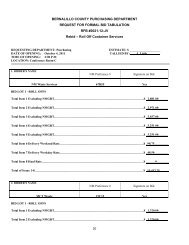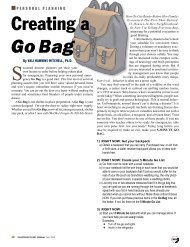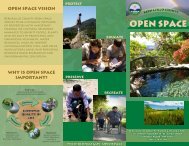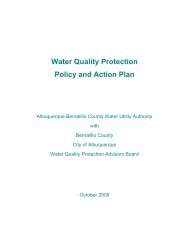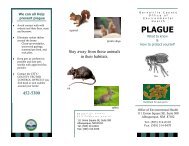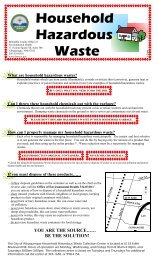East Mountain Trails & Bikeways Master Plan - Bernalillo County
East Mountain Trails & Bikeways Master Plan - Bernalillo County
East Mountain Trails & Bikeways Master Plan - Bernalillo County
Create successful ePaper yourself
Turn your PDF publications into a flip-book with our unique Google optimized e-Paper software.
trailheads (2-5 parking spaces), c) neighborhood<br />
access points (no parking spaces), and d) major<br />
recreation use areas. The major recreation use<br />
areas are the locations where a dedicated trail<br />
use, in conjunction with an organized trail user<br />
group and a willing landowner, could occur after<br />
detailed planning and responsibilities are formally<br />
outlined in an agreement.<br />
The major recreation use areas are proposed as<br />
a concept in response to motorized<br />
recreational users who enjoy ATV, motorbike,<br />
and off-road jeep use. Some of these users<br />
participated in the steering committee and public<br />
meetings. Motorized recreational uses are<br />
allowed within the Cedro Peak Recreational Area<br />
managed by the Sandia Ranger District and<br />
within the <strong>Master</strong> <strong>Plan</strong> area. Almost all proposed<br />
trail corridors are within ¼ mile of a residence,<br />
school or within NMDOT or <strong>Bernalillo</strong> <strong>County</strong><br />
rights-of-way and are therefore currently off-limits<br />
to motorized users. <strong>Bernalillo</strong> <strong>County</strong> and<br />
NMDOT do not allow recreational motorized uses<br />
within their respective rights-of-way. <strong>County</strong><br />
Ordinance 58-105, prohibits operation of<br />
motorized recreational vehicles within ¼ mile of<br />
any residence or school, except on private<br />
property. Development of major recreation use<br />
areas for motorized users will be facilitated by<br />
<strong>Bernalillo</strong> <strong>County</strong> only if and when such users<br />
have an established organization, commit to<br />
stewardship of the land, and are willing to enter<br />
into binding agreements with underlying<br />
landowners. The New Mexico State Legislature<br />
adopted ATV legislation in 2005 that could affect<br />
future development of motorized parks and trails.<br />
Future trail funding is expected to come from<br />
federal, state, local, and possibly grant sources<br />
listed below. Adoption of this <strong>Master</strong> <strong>Plan</strong> by the<br />
Board of <strong>County</strong> Commissioners and inclusion of<br />
identified NMDOT and BCPWD maintained roads<br />
in the MRCOG’s Transportation Improvement<br />
Program are necessary requirements for funding<br />
by federal and state sources.<br />
• Federal – Transportation Equity Act for the<br />
21 st Century and its successor (subject to<br />
Congressional approval in 2005), Surface<br />
Transportation Program Enhancements,<br />
Congestion Mitigation and Air Quality,<br />
National Highway System, and Recreational<br />
<strong>Trails</strong> Federal Grant Program<br />
• State – New Mexico Legislative Capital<br />
Outlay or Memorial appropriation bills, Land<br />
and Water Conservation Fund<br />
• Local – <strong>Bernalillo</strong> <strong>County</strong>’s “Five Percent<br />
Trail Set Aside” Ordinance (Chapter 2, Article<br />
4), <strong>East</strong> <strong>Mountain</strong> Park Impact Fees<br />
(Chapter 46)<br />
Trail corridor projects are prioritized in the<br />
<strong>Master</strong> <strong>Plan</strong>, but priorities are intended to be<br />
flexible in order to respond to segment-specific<br />
funding or road rehabilitation opportunities,<br />
private sector development timing or growth<br />
pressures, and public demand. The top three<br />
area segments for implementation are Frost<br />
Road, Gutierrez Canyon Road, and Juan Tomas<br />
Road.<br />
Future trail development implementation will<br />
be an on-going process. BCPR has received not<br />
only formal support for the <strong>Master</strong> <strong>Plan</strong> from the<br />
<strong>East</strong> <strong>Mountain</strong> Coalition of Neighborhoods and<br />
Landowner Associations, but has also secured<br />
their commitment to serve as a <strong>Trails</strong> Advocacy<br />
Committee. It is envisioned that over the longterm,<br />
the <strong>Trails</strong> Advisory Committee will work<br />
with BCPR and BCPWD on designing trail<br />
segments, pursuing trail development funds,<br />
serving as “eyes and ears” on trail maintenance<br />
and enforcement issues, serving as a liaison to<br />
neighborhood associations, and developing a<br />
trail steward program. The National Park Service<br />
Rivers, <strong>Trails</strong> and Conservation Assistance<br />
Program has agreed to work with BCPR and the<br />
<strong>East</strong> <strong>Mountain</strong> Coalition in 2005 to facilitate their<br />
involvement in plan implementation.<br />
Page ii<br />
EAST MOUNTAIN TRAILS AND BIKEWAYS MASTER PLAN



